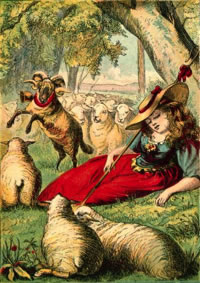Introduction

Source: Little Bo-Peep, Joseph Martin Kronheim, Project Gutenberg
Little Bo Peep has lost her sheep
And doesn’t know where to find them;
Leave someone alone and it’ll come home,
Wagging his tails behind you.
Wait a minute — something is wrong. This children’s verse has a problem besides lost sheep and a lack of rhyme: the pronouns in the last two lines are incorrect! Let’s look at all the pronouns in the poem to figure out which ones are used correctly and which ones aren’t.
In the first line, Little Bo Peep’s name doesn’t indicate gender for certain, but we know she is a girl; the feminine pronoun her, therefore, is correct because it refers to the feminine antecedent Little Bo Peep. The noun sheep might be singular or plural. In this case, the pronoun them at the end of the second line tells us the antecedent sheep is plural. Because sheep and them agree in number, the pronouns that refer to the sheep in the last two lines must also be plural (them, they’ll, their, them). Fortunately for Miss Peep and her sheep, the nursery rhyme makes sense and is grammatically correct when those four pronouns are used.
Although they tend to get lost in the more colorful, perhaps more interesting words, pronouns are important and must be used properly in order for writing to be logical and to have a chance of being grammatically accurate. Why use pronouns at all? The answer is that pronouns replace nouns to keep our writing from getting boring and repetitive. For example, “Little Bo Peep” without pronouns (as shown in the box) is mind-numbing and monotonous. You can’t simply use pronouns and hope for the best; you must learn how to use them properly.
Little Bo Peep has lost Little Bo Peep’s sheep
And doesn’t know where to find the sheep;
Leave the sheep alone and the sheep will come home,
Wagging the sheep’s tails behind the sheep.
Although the focus of this lesson is editing for pronoun reference and pronoun-antecedent agreement, let’s begin with a review of general information about pronouns. If you feel confident that you can recognize the different kinds of pronouns, skip the section “Types of Pronouns” and move on to the section “Pronoun Agreement” for practice in pronoun reference and pronoun-antecedent agreement. If you’re not sure about your pronoun mastery, do the activity at the end of the “Types of Pronoun” section to test yourself. Mastering each of the sections in this lesson will improve the clarity, correctness, and effectiveness of your writing.